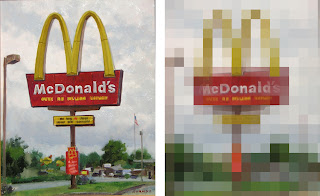Graphic LA - 106-127
Process:
Shape design, assigning color, adding foreground, more details, modeling form, erasing edges, details and adjustments, additional form finding.
Final stages involve adding detail, refining edges, refining shapes, adjusting color and value, adjusting atmosphere and organizing/orchestrating/fine tuning the overall effect/impression.

Find...
3 main shapes
3 main values
3 main levels
Flat block in and then slowly build up detail. Always keeping perspective spot on!

Color and Light
Chapter 8 - Visual Perception
A World Without Color
Draining color our of an image, it is still possible to understand what's going on, but much of the emotional flavor is missing without color.
Tone and Color:
Rods and Cones cooperate to create an interpretation of reality.
Is Moonlight Blue?
It's actually slightly reddish. It appears blue because our visual system plays tricks on us when viewing objects in very dim light.
Moonlight is sunlight reflected from the moon's grey surface.

Edges and Depth
Edges: painterly control of blurriness, especially along the boundary of a form.
Depth of Field -
Creating the illusion of focus. Our mind sees everything in focus at once because our eyes adjust to different depths very quickly.
Color Oppositions
Complements suggest an opposition of elemental principles like fire and ice.
Antagonistic pairings seem to correspond to the way our visual systems are wired.

Color Constancy
Color constancy refers to our automatic habit of interpreting local colors as stable and unchanging, regardless of the effects of colored illumination, the distraction of cast shadows, and the variations of form modeling.
We base a scene off of context clues. We are constantly make such inferences.

Adaptation and Contrast
The experience of one color affects the way we perceive other colors.
The appearance of colors is influenced by 5 factors:
1. Simultaneous contrast - background inducing opposite qualities in an object sitting in front of it.
2. Successive contrast - Looking at one color changes the next color we see.
3. Chromatic adaptation - Balanced impression of color and light levels from experience.
4. Color constancy - Chromatic adaptation and experience means colors appear consistent.
5. Size of an object - The smaller the object, the less distinct the color appears to be.

Appetizing and Healing Colors
Can certain colors or certain groupings of colors promote well-being, or even healing?
"Colors express the main psychic functions of man."
Color associations:
Using colors to the benefit of what the viewer is supposed to feel or do.

No comments:
Post a Comment